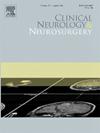评估帕金森病跌倒的预后因素:基于性别的分析
IF 1.8
4区 医学
Q3 CLINICAL NEUROLOGY
引用次数: 0
摘要
跌倒是帕金森病(PD)中一种常见且使人衰弱的并发症。以前的研究主要集中在普遍跌倒或疾病晚期的队列上。本研究评估了早期falls-naïve队列中按性别分层的跌倒风险因素。方法:共172例PD患者(结果:研究样本中,女性61例(35.4 %)。在基线时,女性和男性PD组在年龄、病程和UPDRS评分方面具有可比性,尽管女性PD患者的UPDRS IV评分更高。在平均3.9(3.0)年的随访期间,有13名女性PD患者(21.3% %)和18名男性PD患者(16.2% %)出现跌倒。在女性PD中,运动波动(HR[95 %]= 1.8 [1.3 - 2.6],p )。结论:我们的研究结果表明,女性和男性早期PD患者跌倒的危险因素存在差异,这可能对临床管理具有重要意义。本文章由计算机程序翻译,如有差异,请以英文原文为准。
Evaluating prognostic factors for falls in Parkinson's disease: A sex-based analysis
Introduction
Falls are a common and debilitating complication in Parkinson's disease (PD). Previous studies have primarily focused on cohorts with prevalent falls or advanced disease stages. This study assessed risk factors for falls in early-stage falls-naïve cohort stratified by sex.
Methods
A total of 172 PD patients (<5 years disease duration) were selected from a registry-based study that reported no falls at baseline. All patients were assessed with a standardized data extraction form and falls were defined according to UPDRS Item 13. Hazard Ratios were calculated with univariable and stepwise multivariable Cox Proportional Hazard regression models.
Results
Among the study sample, 61 (35.4 %) patients were female. At baseline, female and male PD groups were comparable in terms of age, disease duration, and UPDRS scores, although female PD patients had higher scores for UPDRS IV. Over a mean follow-up period of 3.9 (3.0) years, falls were reported in 13 female (21.3 %) and 18 male (16.2 %) PD patients. In female PD, motor fluctuations (HR [95 %] = 1.8 [1.3 – 2.6], p < 0.001) and postural stability (HR [95 %] = 4.2 [1.6 – 10.6], p = 0.003) emerged as significant predictors for falls, whereas in male PD, stepwise Cox regression selected freezing of gait (HR [95 %] = 2.0 [1.0 – 4.2], p = 0.053) and postural instability (HR [95 %] = 2.2 [0.89 – 5.4], p = 0.089) as the primary predictors for falls, although they were non-significant.
Conclusion
Our findings suggest that the risk factors for falls differ between female and male early-stage PD patients, which may have important implications for clinical management.
求助全文
通过发布文献求助,成功后即可免费获取论文全文。
去求助
来源期刊

Clinical Neurology and Neurosurgery
医学-临床神经学
CiteScore
3.70
自引率
5.30%
发文量
358
审稿时长
46 days
期刊介绍:
Clinical Neurology and Neurosurgery is devoted to publishing papers and reports on the clinical aspects of neurology and neurosurgery. It is an international forum for papers of high scientific standard that are of interest to Neurologists and Neurosurgeons world-wide.
 求助内容:
求助内容: 应助结果提醒方式:
应助结果提醒方式:


